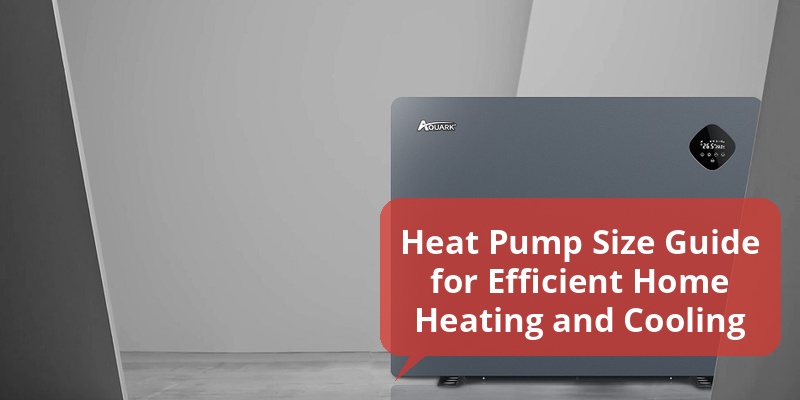Choosing the correct heat pump size is crucial for ensuring efficient heating and cooling performance in residential homes. This guide helps homeowners and professionals understand how to select the right heat pump size tailored to their property’s needs, considering factors like square footage, insulation, climate, and energy efficiency.
| Factor | Impact on Heat Pump Size |
|---|---|
| Home Size (Square Footage) | Larger homes require heat pumps with higher capacity (BTUs) |
| Climate Zone | Colder climates need more powerful units to maintain indoor temperatures |
| Insulation Quality | Better insulation reduces heat loss/gain, allowing smaller units |
| Window Types and Quantity | More or inefficient windows increase heat load, affecting size |
| Heating and Cooling Load Calculation | Accurate load assessments optimize heat pump efficiency |
Understanding Heat Pump Capacity and BTUs
Heat pump capacity is measured in British Thermal Units (BTUs), which quantify the amount of heat a unit can add or remove from a space per hour. Selecting a unit with the correct BTU rating is essential for maintaining comfort and system efficiency.
Under-sizing a heat pump results in insufficient heating or cooling, causing the system to run longer and wear out faster. Over-sizing leads to frequent cycling on and off, wasting energy and reducing equipment lifespan.
Factors Affecting Heat Pump Size Selection
Home Square Footage and Layout
One of the primary determinants of heat pump size is the home’s total square footage. Larger homes require units with higher BTU capacities to maintain temperature evenly.
Additionally, the floor plan and number of rooms impact airflow and load calculations. Open floor plans may allow efficient air distribution, while segmented layouts might require zoning or multiple units.
Climate Zone Considerations
The region’s climate critically influences heat pump sizing. Homes in colder regions experience higher heating demands, necessitating larger capacity units.
In moderate climates, smaller units may suffice due to reduced temperature extremes. Energy-efficient heat pumps today utilize variable-speed compressors to adapt to varying loads across seasons.
Insulation Quality and Building Envelope
Well-insulated homes minimize heat loss during winter and heat gain during summer. This efficiency allows for smaller heat pump units.
Poor insulation or older homes with drafty windows require larger units to compensate for greater thermal transfer.
Window Size and Type
Windows contribute significantly to a home’s heating and cooling load. The size, glazing type, and orientation of windows affect solar heat gain and air leakage.
Energy-efficient double or triple-pane windows reduce load, allowing smaller heat pumps. Conversely, large or single-pane windows increase system size needs.
Calculating Heat Pump Size Requirement
Several methods exist for calculating heat pump size, with the most accurate being a professional load calculation using Manual J or similar protocols.
- Manual J Calculation: The industry-standard method assessing heating and cooling loads based on building characteristics.
- Rule-of-Thumb Estimates: Approximate sizing based on square footage, generally ranging from 30 to 60 BTUs per square foot.
For example, a well-insulated 2,000 sq. ft. home in a moderate climate might require a 60,000 BTU heat pump (or 5 tons), assuming 30 BTUs per square foot.
Importance of Professional Load Assessments
While simplified formulas provide rough estimates, professional HVAC contractors use detailed calculations factoring in:
- Home orientation and shading
- Air infiltration rates
- Occupant lifestyle and appliance heat generation
- Local climate data
Accurate load assessment ensures optimized equipment size, maximizes energy savings, and enhances comfort.
Variable-Speed vs. Single-Speed Heat Pumps
Modern heat pumps come with single-speed or variable-speed compressors. Single-speed units operate at full capacity or not at all, requiring precise sizing to avoid inefficiencies.
Variable-speed heat pumps adapt their output to meet real-time heating and cooling needs, allowing smaller nominal sizes while maintaining comfort in diverse settings.
Impact of Heat Pump Sizing on Energy Efficiency and Costs
Properly sized heat pumps consume less energy and reduce utility bills. Oversized units waste electricity through short-cycling, while undersized ones strain systems and may increase maintenance costs.
Investing in an appropriately sized heat pump can lower lifetime operating expenses and improve environmental sustainability.
Selecting Heat Pump Size Based on Home and Climate
| Climate Zone | Typical BTU Per Square Foot | Example for 1,500 Sq. Ft. Home |
|---|---|---|
| Mild Climate | 30-35 BTU | 45,000-52,500 BTU (3.75-4.4 tons) |
| Moderate Climate | 35-45 BTU | 52,500-67,500 BTU (4.4-5.6 tons) |
| Cold Climate | 45-60 BTU | 67,500-90,000 BTU (5.6-7.5 tons) |
Tips for Optimal Heat Pump Performance
- Regular Maintenance: Clean filters and check refrigerant levels to ensure efficiency.
- Proper Installation: Ensure professional setup with correct unit sizing.
- Use Programmable Thermostats: Optimize temperature control and reduce energy consumption.
- Seal and Insulate: Minimize leaks and thermal losses in the home envelope.
- Consider Zoning: Heat or cool specific areas independently for efficiency.
